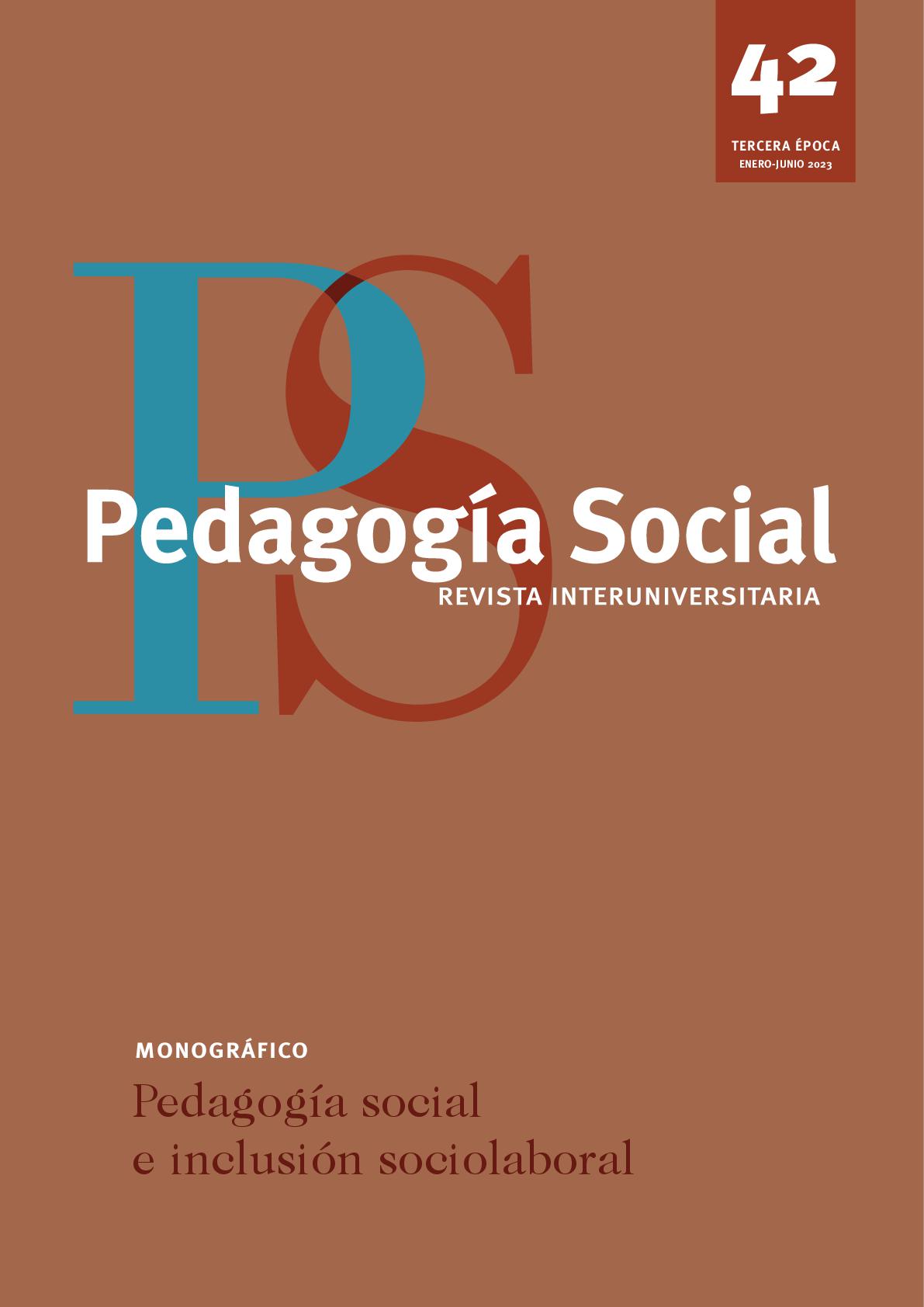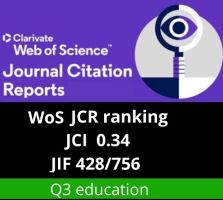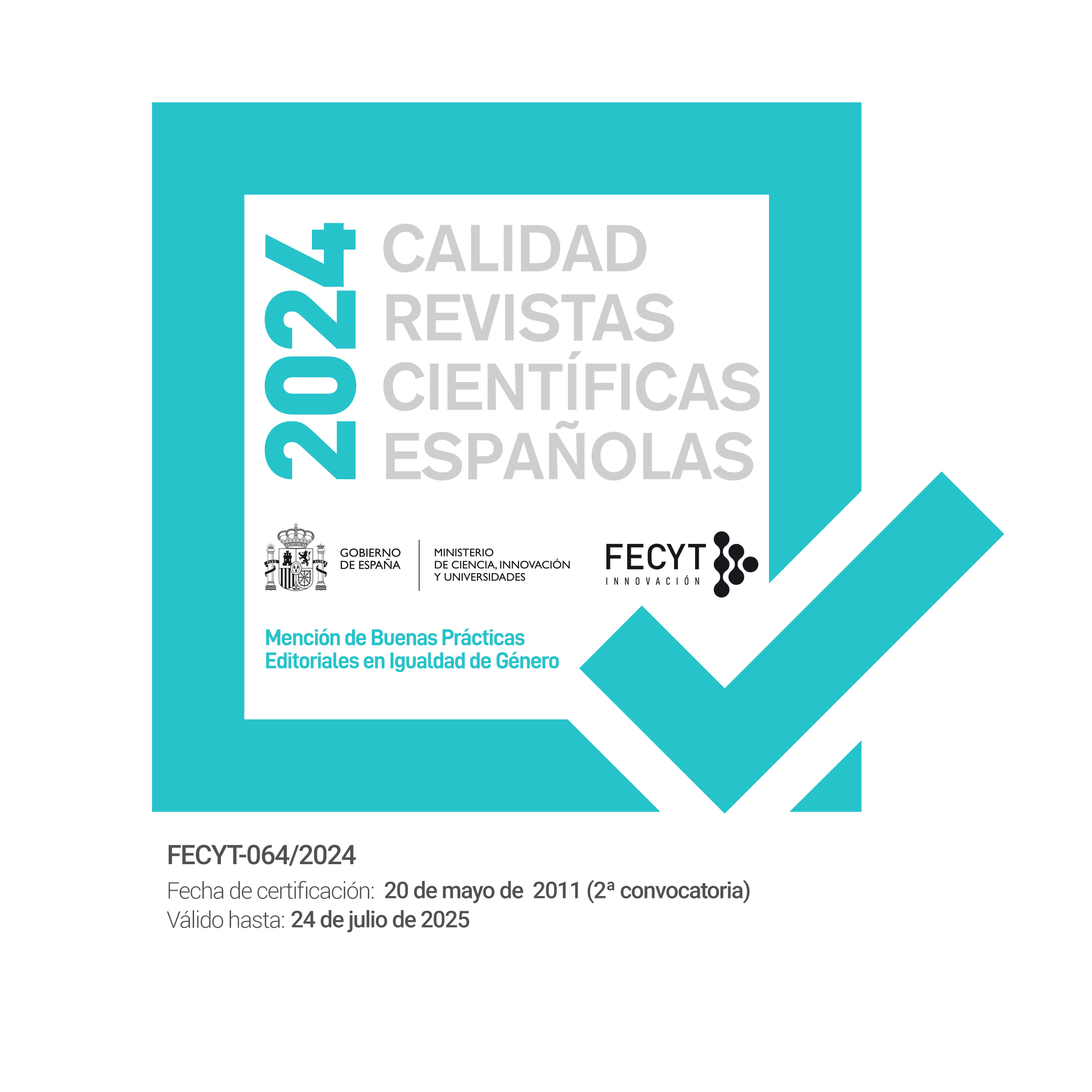¿Cómo acompañar la inclusión? Elementos de protección y buenas prácticas en programas de inserción sociolaboral
DOI:
https://doi.org/10.7179/PSRI_2023.42.05Palabras clave:
Inclusión social, inserción sociolaboral, acompañamiento, buenas prácticas, brecha digitalResumen
La inserción laboral es un ámbito de intervención socioeducativa que puede contribuir a la inclusión social de diferentes personas y grupos. A partir de una revisión de la literatura sobre elementos de protección en los procesos de inserción sociolaboral, y teniendo en cuenta especialmente la situación vivida durante la pandemia por COVID-19 en los años 2020-2022, en este estudio se ha identificado –a través de 109 cuestionarios y 21 entrevistas realizadas de forma grupal a agentes socioeducativos– cuáles de estos elementos están presentes en proyectos de inserción que se desarrollan actualmente en 4 países del contexto iberoamericano y se ha explorado cómo definen las ‘buenas prácticas’ en este ámbito y qué acciones efectivas existen. Los resultados, desglosados por países (Brasil, España, Colombia y México), indican que en los diferentes proyectos socioeducativos se trabajan elementos de protección de tres tipos: desarrollo de competencias personales y profesionales; apoyo del contexto familiar y social; y elementos propiamente institucionales relacionados con las intervenciones de intermediación sociolaboral y apoyo social. En cuanto a las buenas prácticas, los agentes técnicos que trabajan en los proyectos de inserción asocian este término con características metodológicas de su intervención (acompañamiento, empatía, personalización) y/o con el logro de resultados (calidad de vida, empoderamiento, empleabilidad). Los informantes identifican nuevos retos surgidos durante la pandemia, como la alfabetización digital o la salud mental, e ilustran con algunos ejemplos prácticas exitosas que desarrollan. El artículo concluye con la mención al enfoque socioeducativo en los programas de inserción sociolaboral y la presentación de dos propuestas de profundización en el tema de estudio.
Descargas
Citas
Alam, K., & Imran, S. (2015). The digital divide and social inclusion among refugee migrants. Information Technology and People, 28(2), 344-365. http://doi.org/10.1108/ITP-04-2014-0083
ANECA (2004). Libro Blanco del Título de Grado en Pedagogía y Educación Social (vol. I). Agencia Nacional de Evaluaciónde la Calidad y Acreditación. http://www.aneca.es/media/150392/libroblanco_pedagogia1_0305.pdf
Annoni, D., Souza Silva, K. & Martini Dos Santos, G. (2022). Solidarity Economy and Social Inclusion: The Immigrant Fair in Florianópolis, Brazil. Development Policy Review, 40(2). http://doi.org/10.1111/dpr.12564
Asociación Centro Trama (2014). Programa Apoyo Inserción Sociolaboral: Trabajando el presente, construyendo el futuro. https://www.mites.gob.es/es/estrategia-empleo-joven/logos/planes/Plan_Actuacixn_Centro_Trama_541.pdf
Ballesteros, B. & Gil-Jaurena, I. (coords.). (2012). Diversidad cultural y eficacia de la escuela. Un repertorio de buenas prácticas en centros de educación obligatoria. Ministerio de Educación de España.
Builes Beltrán, C. Y. (2016). “Kioscos Vive Digital”: a digital strategy to promote the connectivity and social inclusion in rural communities in Colombia. International Journal of Psychological Research, 9(1), 126–130. https://doi.org/10.21500/20112084.2107
Berger-Schmitt, R. & Noll, H.H. (2000). Conceptual Framework and Structure of a European System of Social Indicators. EU Reporting Working Paper No. 9. Centre for Survey Research and Methodology (ZUMA), Mannheim.
Bryman, A. (1992). Quantitative and qualitative research: further reflections on their integration, in J. Brannen (comp.) Mixing Methods: Quantitative and Qualitative Research (pp. 57-80). Routledge.
Creswell, J. W. (2009). Research design: qualitative, quantitative and mixed methods approaches (3rd Ed.). SAGE.
Del Pozo Serrano, F.J. (2017). La educación en las prisiones españolas: formación y acción socioeducativa con reclusas drogodependientes. Educación XX1, 20(2), 343-363. https://doi.org/10.5944/educXX1.12180
Flick, U. (2014). La gestión de la calidad en investigación cualitativa. Ediciones Morata.
Garcés, C.R.R., & Soto, J.A.M. (2018). Capital humano y factores culturales: Determinantes de la inserción laboral femenina en Chile. Perfiles Latinoamericanos, 26(52), 1-22. https://doi-org.bibliotecauned.idm.oclc.org/10.18504/pl2652-008-2018
García Aguilera, F.J., Leiva Olivencia, J.J., Eduardo Espíndola, F.J., & Flaviany Aparecida, P.F. (2021). Inclusión social de mujeres rurales a través de programas de alfabetización digital para el empleo. Revista Complutense de Educación, 32(1), 15-25. https://doi.org/10.5209/rced.67590
Gómez, J.A., Hernández, M., & Romero, E. (2017). Empoderamiento social y digital de los usuarios en riesgo de exclusión de la Biblioteca Regional de Murcia, España. El profesional de la información, 26(1), 20-32. https://doi.org/10.3145/epi.2017.ene.03
Guerrero, C. (2005). Itinerarios de inserción sociolaboral: una propuesta metodológica para personas en riesgo de exclusión social. Revista REDSI-Red Social Interactiva, 6.
Hunter, B., & Jordan, K. (2010). Explaining social exclusion: towards social inclusion for Indigenous Australians. Australian Journal of Social Issues, 45(2), 243-265. https://doi.org/10.1002/j.1839-4655.2010.tb00177.x
Laparra, M., Zugasti Mutilva, N., & García Lautre, I. (2021). The Multidimensional Conception of Social Exclusion and the Aggregation Dilemma: A Solution Proposal Based on Multiple Correspondence Analysis. Social Indicators Research, 158(2), 637-666. https://doi.org/10.1007/s11205-021-02707-6
Levitas, R., Pantazis, C., Fahmy, E., Gordon, D., Lloyd-Reichling, E., & Patsios, D. (2007). The multi-dimensional analysis of social exclusion. https://repository.uel.ac.uk/item/8666q
Pachón Muñoz, W. (2017). Inclusión social de actores del conflicto armado colombiano: Retos para la educación superior. Desafíos, 30(1), 279-308. https://doi.org/10.12804/revistas.urosario.edu.co/desafios/a.4917
Paraschiv, D., Manea, D., Titan, E., & Mihai, M. (2021). Development of an aggregated social inclusion indicator. Disparities in the European Union on inclusion/exclusion social determined with social inclusion index. Technological and Economic Development of Economy, 27(6), 1301-1324. https://doi.org/10.3846/tede.2021.15103
Peréz García, F., Aldas Manzano, J., Peiró Silla, J.M., Serrano Martínez, L., Miravalles Perez, B., Soler Guillén, A., & Zaera Cuadrado I. (2018). Itinerarios de inserción laboral y factores determinantes de la empleabilidad: Formación universitaria versus entorno. Fundación BBVA.
Sala, J., Jariot, M., Villalba, A., & Rodríguez, M. (2009). Analysis of factors involved in the social inclusion process of young people fostered in residential care institutions. Children and Youth Services Review, 31(12), 1251–1257. https://doi.org/10.1016/j.childyouth.2009.05.010
Servicio Público de Empleo Estatal (2019). Plan reincorpora-T 2019-2021: triennial plan for preventing and reducing longterm unemployment. SEPE. https://cpage.mpr.gob.es/producto/plan-reincorpora-t-2019-2021-2/
Thoene, U., & Turriago-Hoyos, Á. (2017). Financial inclusion in Colombia: A scoping literature review. Intangible Capital, 13(3), 582-614. https://doi.org/10.3926/ic.946
Zunino, G., Preckler M., Carbajal, F., Cazulo, P., & Ortíz L. (2022). Empleo juvenil y emprendimiento en América Latina y el Caribe. Organización de Estados Iberoamericanos para la Educación, la Ciencia y la Cultura (OEI). https://oei.int/publicaciones/empleo-juvenil-y-emprendimiento-en-america-latina-y-el-caribe
Descargas
Publicado
Cómo citar
Número
Sección
Licencia

Esta obra está bajo una licencia internacional Creative Commons Atribución-NoComercial-CompartirIgual 4.0.
Derechos de reproducción y archivo
La versión publicada de los artículos podrá ser autoarchivada por sus autores en repositorios institucionales y temáticos de acceso abierto. No obstante la reutilización total o parcial de los mismos en nuevos trabajos o publicaciones deberá ser autorizada por Pedagogía Social. Revista Interuniversitaria.
Los trabajos publicados deberán ser citados incluyendo el título de la Revista, Pedagogía Social. Revista Interuniversitaria, nº, páginas y año de publicación.
Responsabilidades éticas
Pedagogía Social. Revista Interuniversitaria no acepta material publicado anteriormente en otros documentos. Los/as autores/as son responsables de obtener los permisos oportunos para reproducir parcialmente material de otras publicaciones y citar correctamente su procedencia. Estos permisos deben solicitarse tanto al autor/a como a la editorial que ha publicado dicho material.
Es obligación de Pedagogía Social. Revista Interuniversitaria detectar y denunciar prácticas fraudulentas.
En la lista de autores/as firmantes deben figurar únicamente aquellas personas que han contribuido intelectualmente al desarrollo del trabajo.
La revista espera que los/as autores/as declaren cualquier asociación comercial que pueda suponer un conflicto de intereses en conexión con el artículo remitido.
Los autores deben mencionar en el manuscrito, preferentemente en el apartado del método, que los procedimientos utilizados en los muestreos y controles han sido realizados tras la obtención de consentimiento informado.
La revista no utilizará ninguno de los trabajos recibidos con otro fin que no sea el de los objetivos descritos en estas normas.
Aviso de derechos de autor/a
© Pedagogía Social. Revista Interuniversitaria. Los originales publicados en las ediciones impresa y electrónica de esta Revista son propiedad del Pedagogía Social. Revista Interuniversitaria, siendo necesario citar la procedencia en cualquier reproducción parcial o total.
Salvo indicación contraria, todos los contenidos de la edición electrónica se distribuyen bajo una licencia de uso y distribución “Creative Commons Reconocimiento-No Comercial 3.0 España” (CC-by-nc). Puede consultar desde aquí la versión informativa y el texto legal de la licencia. Esta circunstancia ha de hacerse constar expresamente de esta forma cuando sea necesario.






